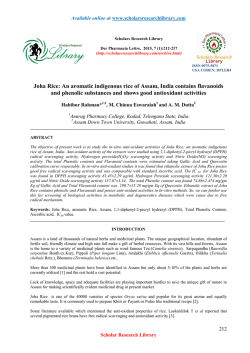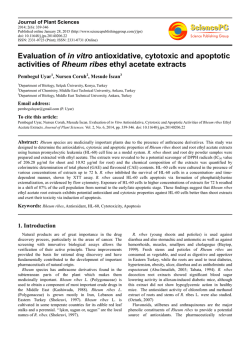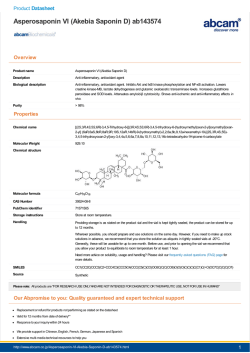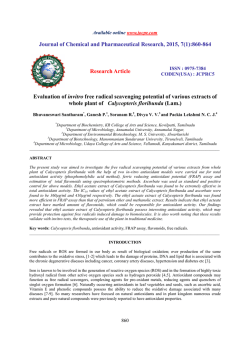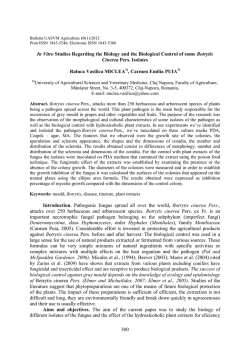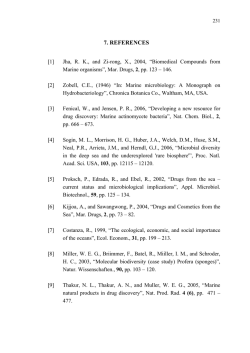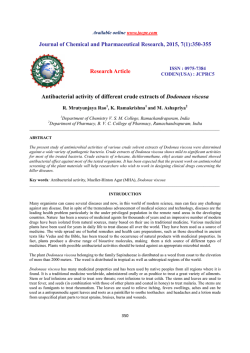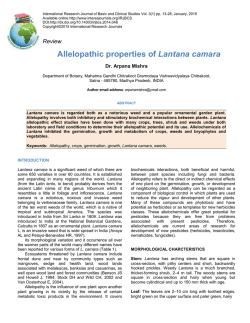
PDF (212KB)
Letter to the Editor Iran J Public Health, Vol. 44, No.1, Jan 2015, pp.142-144 Antioxidant Activity of Plantago Species in Vegetative and Flowering Stages * Lăcrămioara OPRICĂ, Mihaela IVAN, Marius Nicusor GRIGORE, Maria Magdalena ZAMFIRACHE Faculty of Biology, Alexandru Ioan Cuza University, Iasi, Romania *Corresponding Author: Email: [email protected] (Received 18 Sep 2014; accepted 05 Oct 2014) Dear Editor in Chief Plantago L. genus (Plantaginaceae) includes a large number of species differing in salt tolerance; many of them are adapted to live in saline environments, thus making the genus Plantago a good model for comparative studies about responses to salinity stress (1). Plantago genus includes species wellknown as medicinal plants and others can be used for food and animal feeding (P. coronopus, P. lanceolata, P. serraria). A large amount of data about the Plantago species usage refers to the leaves both in traditional and modern medicine. Extensive use of many Plantago species based on a remarkable variety of curative properties: astringent, antioxidant, anti-fungal, anti-cancer, antibacterial, spasmolytic, antiviral, antihyperlipidemic, immunostimulant, antitoxic, epithelising, pro-coagulant, anthelmintic etc (2). The seeds of several Plantago species are used as laxative, due to their emollient and diuretic properties. On the other hands, the seeds mucilage is an excellent thickening agent used in cosmetics but also as a stabilizer in the ice-cream industry or chocolate products (3). In addition, some Plantago species are also included in the diet being used as fresh salads, soups or side dish as well as herbal tea (4). Plantago species contain several phytochemicals like caffeic acid derivatives (caffeic acid, ferulic acid, chlorogenic acid, plantamajoside R, aceteoside R, p-cumaric acid and vanillic acid), lipids, 142 mucilage polysaccharides (plantaglucide, glucomannon), monoterpenoids (linalool), flavonoids and flavone glucosides (aspigenin, scutallarin, plantagonin, baicalein, luteolin, luteolin 7 glucoside, hispidulin 7 glucuronide), iridoid glycosides (aucubin, catapol, gardoside, geniposidic acid, mayoroside, melittoside), as well as terpenoids (loliolid, oleanolic acid and ursolic acid) and tannins. Alkaloids (indicain, plantagonin) and some organic acids have also been detected (5). In addition, Plantago species could be regarded as a possible new source of natural antioxidants (6). Moreover, there is a scenario describing the future in terms of increasing salt-affected areas in agriculture, the scarce of fresh water, food crisis and continuously growing population (7). Thus, there is a serious demand for extending the knowledge about salinity tolerance in plants with economic potential. Nowaday there is a great interest focused on the natural food or medicinal plants due to their wellknown abilities to scavenge free radicals, which are toxic. In this context, we tested the antioxidant activity of five Plantago species (P. maritima L., P. media L., P. lanceolata L., P. coronopus L. and P. schwarzenbergiana Schur), which have been collected different during vegetative and flowering stages. Plantago plant material has been collected from two saline areas located in Northeast (Valea Ilenei nature reserve) and South-East (Dobrogea – Available at: http://ijph.tums.ac.ir Oprică et al.: Antioxidant Activity of Plantago Species in Vegetative … Sulina) of Romania, during April-May and JuneJuly of 2013, corresponding to vegetative stage and anthesis, respectively. Antioxidative activities of methanol extracts from plantain species were characterized by the DPPH scavenging test. Thus, DPPH reacts with an antioxidant compound, which can donate hydrogen and reduces DPPH. Moreover DPPH is a kind of stable organic radical and the capacity of biological compounds to scavenge the DPPH radical can be expressed as its magnitude of antioxidant ability. The plants with higher capacity donating of hydrogen have shown higher DPPH free radical scavenging activity. In fact, antioxidant activity is monitored by measuring the change in colour (from deep violet to light yellow) which was detected by spectrophotometric method at 517 nm. The DPPH radical scavenging activity was recorded in terms of % inhibition (8). Data on the inhibition percentage (of DPPH) of leaves methanol-extractions of Plantago species are depicted in Table 1. The results revealed that the DPPH scavenging activity in extracts of Plantago species in vegetative stage varied from 21.70±5.14% to 90.86±3.13% in P. schwarzenbergiana and P. lanceolata, respectively. Table 1: DPPH scavenging activities (as % inhibition) of methanolic extracts from the leaves of five Plantago species in vegetative and flowering stage (mean ± standard deviation, n = 5) Collecting point area Dobrogea Valea Ilenei Species P. maritima P. media P. lanceolata P. coronopus P. media P. lanceolata P. schwarzenbergiana Regarding species sampled in flowering stage the minimum DPPH scavenging activity was recorded in the extracts of P. coronopus (21.56±1.95%) while the maximum DPPH scavenging activity was observed in P. lanceolata (94.17±0.36%) collected from Valea Ilenei. For the same samples, higher % inhibition in P. lanceolata extracts during both stages indicates better scavenging activity or antioxidant potential. Similar results have been also reported by Miser-Salihoglu et al. (2013), when studying the antioxidant activity of some herbals used in folk medicine; it has found that it was higher for P. major ssp. major and P. lanceolata as evaluated by the same method (9). There is no significant difference between the antioxidant ability of Plantago extracts obtained from plants collected during vegetative and flowering stages. Nevertheless, concerning P. coronopus from Dobrogea, results showed that scavenging effect Available at: http://ijph.tums.ac.ir Growth stage Vegetative stage Flowering stage (% inhibition) (% inhibition) 49.88±3.86 51.21±1.37 38.12±0.17 44.56±1.24 42.41±1.16 40.29±4.85 71.73±6.52 21.56±1.95 81.77±4.57 77.67±4.51 90.86±3.13 94.17±0.36 21.70±5.14 45.56±14.64 was three fold higher in case of vegetative stage than flowering. On the other hands, P. schwarzenbergiana collected from Valea Ilenei revealed that antioxidant activity was twofold higher in flowering stage that vegetative stage. Our results are in agreement with other data (10) evidencing that the extract prepared from Plantago species possess significant antioxidant activity. Acknowledgments The authors declare that there is no conflict of interests regarding the publication of this paper. References 1. Turkan I, Tijen D, Hediye Sekmen A (2013). The regulation of antioxidant enzymes in two Plantago species differing in salinity tolerance under 143 Iran J Public Health, Vol. 44, No.1, Jan 2015, pp.142-144 2. 3. 4. 5. 6. 144 combination of waterlogging and salinity. Funct Plant Biol, 40 (5): 484-493. Ianovici N, Tarau G, Liviatodosi A, Iriza E, Danciu A, Tolea L, Tudosie D, Munteanu F, Bogdan D, Ciobanica V (2010). Contributions to the characterization of Plantago species from Romania. Ann of West Univ of Timişoara, ser. Biology, 13: 37-76. Ifrim C (2013). Contributions to the seeds’ study of some species of the Plantago L. genus. J Plant Develop, 20: 35 – 43. Heimler D, Isolani L, Vignolini P, Tombelli S, Romani A (2007). Polyphenol content and antioxidative activity in some species of freshly consumed salads. J Agric Food Chem, 55 (5): 1724-1729. Samuelsen AB (2000). The traditional uses, chemical constituents and biological activities of Plantago major L. A review. J Ethnopharmacol, 1 (1-2): 1-21. Beara I, Lesjak MM, Jovin ED, Balog KJ, Anckov GT, Orcić DZ, Mimica-Dukić NM (2009). 7. 8. 9. 10. Plantain (Plantago L.) species as novel sources of flavonoid antioxidants. J Agric Food Chem, 57 (19): 9268–9273. Grigore MN, Ivanescu L, Toma C (2014). Halophytes. An integrative anatomical study. Springer, Cham, Heidelberg, New York, Dordrecht, London, pp.: 1-2. Miser-Salihoglu E, Akaydin G, Caliskan-Can E, Yardim-Akaydin S (2013). Evaluation of antioxidant activity of various herbal folk medicines. J Nutr Food Sci, 3 (5): 1-9. Molyneux P (2004). The use of the stable free radical diphenylpicrylhydrazyl (DPPH) for estimating antioxidant activity. Songklanakarin J Sci Technol, 26 (2): 211-219. Galvez M, Martin-Cordeo C, Houghton PJ, Ayuso MJ (2005). Antioxidant activity of methanol extracts obtained from Plantago species. J Agric Food Chem, 53 (6): 1927-1933. Available at: http://ijph.tums.ac.ir
© Copyright 2026
